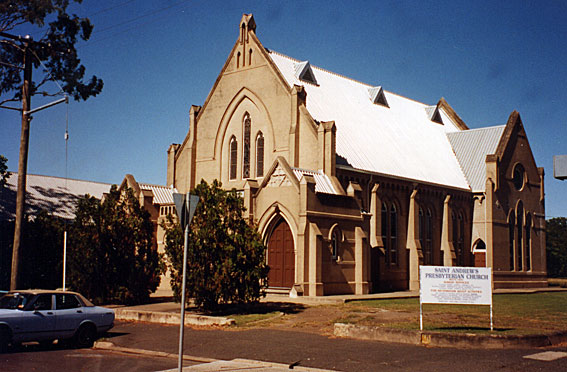
St Andrew's Presbyterian Church, Rockhampton
[Photograph by Howard Baker (1990s)]

St Andrew's Presbyterian Church, Rockhampton
[Photograph by Howard Baker (1990s)]
Historical and Technical Documentation by Geoffrey Cox
© OHTA 2011, 2018 (last updated September 2018)
Located on the Fitzroy River, Rockhampton was settled as a centre for the pastoral industry in the mid 1850s, and proclaimed a township in 1857. Impetus for its rapid early growth came with the discovery of gold at nearby Canoona in 1858, and later at Mount Morgan in 1882. Coal in the Bowen Basin has since become the principal focus for the mining industry in the region. Rockhampton now provides educational, commercial and medical facilities as the regional centre for central Queensland.
The Presbyterians were the first denomination to organise services in Rockhampton, beginning in 1858.1 A church was built in the 1860s, and was named St Andrew's in 1890.2 The new church in Bolsover Street was opened on 15 April 1894, built to the architectural design of the short-lived Brisbane partnership, Voller & Graham.3 This was the firm's major building, chosen in August 1892 in a well-publicised competition that attracted some 24 entries.4

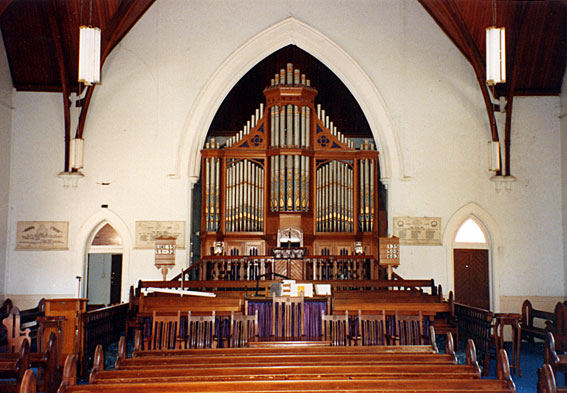
[Photographs by Howard Baker (1990s)]
The organ was built by W.E. Richardson & Sons of Manchester, UK, using tubular-pneumatic action throughout, and was reported to have been completed in their factory by November 1899.5 The published specification was as follows:
| GREAT Open Diapason Dulciana Gamba Stopped Diapason & Hohl Flote Principal Wald Flute Fifteenth SWELL Bourdon Open Diapason Salicional Voix Celeste Lieblich Gedact Gemshorn Piccolo Oboe PEDAL Open Diapason Bourdon Flute Bass COUPLERS Great to Pedal Swell to Pedal Swell to Great Swell Sub Swell Super |
8 8 8 8 4 4 2 16 8 8 8 8 4 2 8 16 16 8 |
[gvd bass] [gvd bass] [Ten.C] A A |
[Swell tremulant]
Tubular-pneumatic action
2 combination pistons to Great Organ
2 combination pistons to Swell Organ
[Balanced swell pedal]
[Pedalboard: radiating & concave]
[Compass: 56/30].6
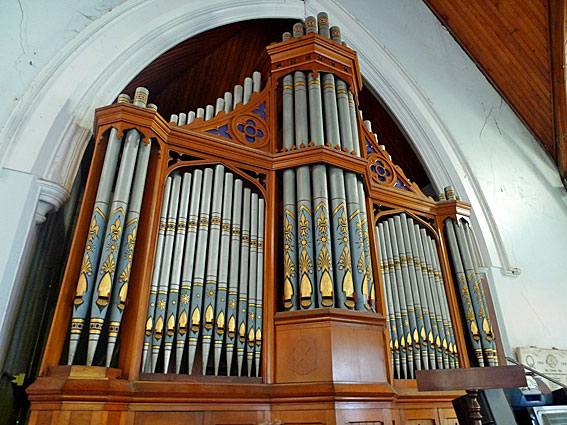
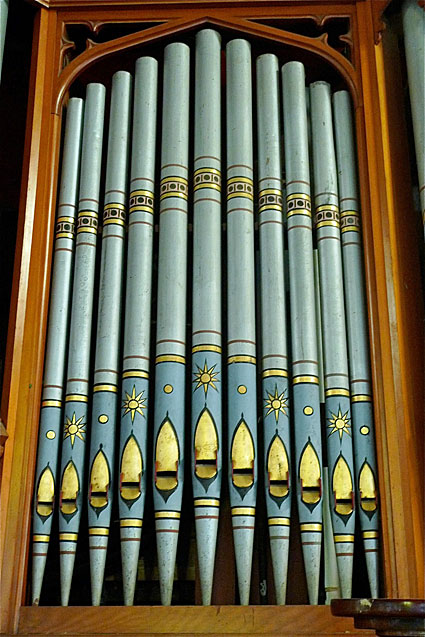
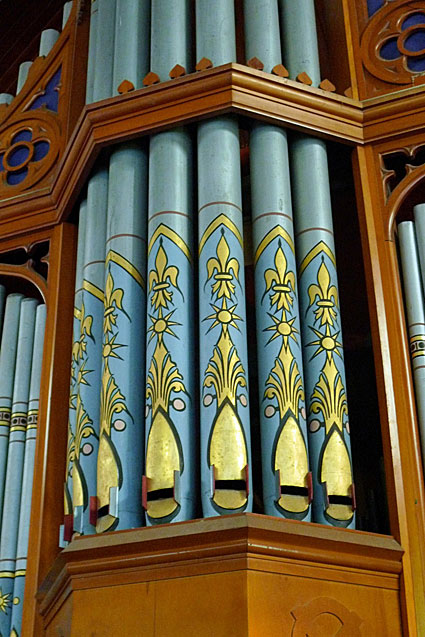
Details of the casework, executed by Charles Richardson, Sydney
[Photographs by Trevor Bunning (November 2010)]
The instrument was installed in Rockhampton in 1900 at a cost of £3,500,7 by Charles Richardson of Sydney, who was the son of W.E. Richardson. Charles Richardson had arrived in Australia in 1882 and established his own firm 'representing W.E. Richardson & Sons of London, Manchester and Preston'. At least eight organs built by the English firm were imported into Australia over three decades, although this was the only example in Queensland.8 An account of the organ's arrival in Rockhampton in April 1900 reveals that the casework for the instrument was constructed in Sydney, and gives details of the opening musical events:
PRESBYTERIAN CHURCH ORGAN.
The new organ for the St. Andrew's Presbyterian Church came to hand on Monday last. The order to erect a fine organ for the church was given to Messrs. W. E. Richardson and Sons, of Manchester, Preston, London, and Sydney, and the organ was constructed at the first-named town. It was shipped to Brisbane in the s.s. Gulf of Siam, and was brought on to Rockhampton on Monday last in the s.s. Dawn. The instrument was landed in no less than eight cases, into which its component parts had been packed. Two of the cases measured 17 ft. by 3 ft. by 3 ft., while another measured 7 ft. by 3 ft. by 7 ft. These cases, which constituted the bulk of the organ, were removed to the old Presbyterian Church in Derby-street. Mr. F. B. Kavanagh, organist of St. Andrew's Church, received a letter on Monday from Mr. C. Richardson, the Sydney representative of the firm who erected the organ, stating that the woodwork case and ornamental front of the organ would be completed in Sydney during the present week, and he would leave with them for Rockhampton without delay, so as to erect the instrument in its proper position in the church. The measurement tonnage of the organ, which was landed on Monday, was twenty-two tons. Arrangements have been made with Mr. S. G. Benson, R.A.M., of Brisbane, to open the instrument by giving an organ recital in Rockhampton in the course of a few weeks. It is intended to give two performances in connection with the opening of the organ. On the first occasion, in addition to the organ recital, there will be a concert, while the second performance will consist of Gaul's sacred cantata, "The Holy City." The cantata will be carried out by a choir consisting of sixty voices, under the direction of Mr. Kavanagh. The choir has been practising assiduously for some time past in order to make the entertainment a complete success.9
The opening musical celebrations extended from Friday 29 June 1900 until the following Tuesday:
ST. ANDREW'S CHURCH NEW ORGAN.
Excellent progress has been made this week with the completion of the new pipe organ which will make so great an attraction to St. Andrew's Presbyterian Church and an equal advancement in the musical status of the city. Mr. G. C. Griffin, who is erecting the organ on behalf of Messrs. Charles Richardson and Co., Sydney, when visited yesterday, said he was extremely pleased to say that the organ would be ready for opening on Friday night. Mr. S. G. Benson, R.A.M., one of Queensland's best organists, will arrive today, and the recitals he has arranged are singularly attractive. The choir committee has issued an elaborate programme for the performances, which commence on Friday evening and extend until the following Tuesday. A chorus of sixty-five voices will be engaged in its production.10
The St Andrew's organ was maintained regularly by Whitehouse Bros of Brisbane, who supplied an electric blower in 1925 at a cost of £95.10.0. In 1926, they rebuilt the Swell and Great key touch boxes, regulated the key action, repaired the coupler action, and made adjustments to the bellows and windchest.11 More substantial changes were made in 1933, when the organ was rebuilt by Whitehouse Bros at a cost of £615.12 The instrument was re-dedicated on Sunday 30 July that year,13 and it was reported in the Rockhampton press as follows:
St. Andrew's Presbyterian Church Organ
This instrument has been entirely rebuilt by Messrs. Whitehouse Bros., the well known Brisbane organ-builders, and it may be said to represent the last word in efficiency. The builders have adopted their own system of tubular-pneumatic action throughout the instrument, by which there is a separate pallet for every pipe, thus eliminating robbing and ensuring perfect speech and repetition, whether the manuals are used singly or coupled.
The instrument has two manuals and pedal organ with detached console nicely placed. The great organ has seven speaking stops. . . . The swell organ has eight stops with an excellent solo variety. . . . The pedal organ has three stops.14
There were clearly no stops added to the instrument at this time, although some of the stop names were slightly changed. It appears that a new console was provided at this time, and that the original windchests were replaced by cone-pallet chests.
Apart from a minor overhaul and cleaning in June 1950,15 the instrument then remained essentially unaltered until 1988 when the action was electrified by H.W. Jarrott of Brisbane. Jarrott also added new couplers.16 He also reportedly revoiced the Swell Oboe, and deployed the 1928 Whitehouse console that had served originally as a three-manual console at the City Congregational Church, Brisbane.17 Repairs to the Great soundboard were undertaken by Jarrott in 1992 following storm damage.18
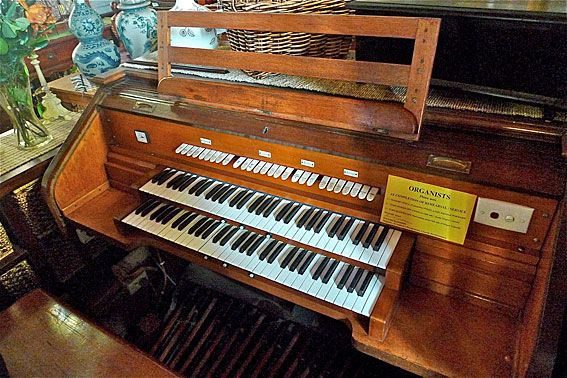
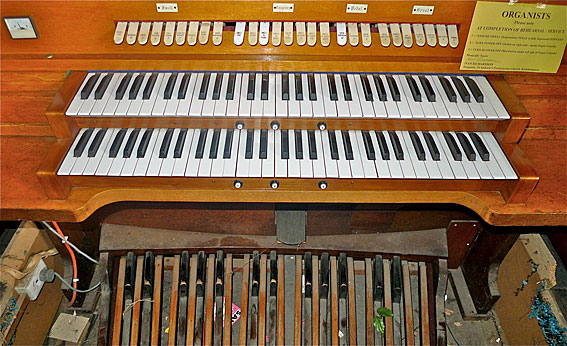
The modified 1928 Whitehouse console, installed by H.W. Jarrott in 1988
[Photographs by Trevor Bunning (November 2010)]

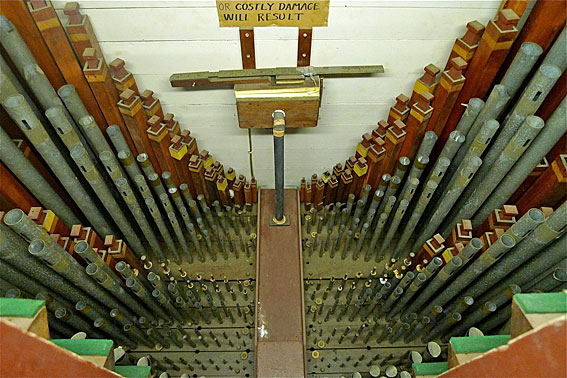
The Great Soundboard and Pipework
[Photographs by Trevor Bunning (November 2010)]
The specification as it now appears on the 1988 console is as follows:
GREAT |
8 8 8 8 4 4 2 16 8 8 8 8 4 2 8 16 16 8 [1988] [1988] [1988] |
Swell tremulant
Electro-pneumatic action
3 combination pistons to Great Organ
3 combination pistons to Swell Organ
Balanced swell pedal
Pedalboard: radiating & concave
Compass: 61/30.19
In October 2002 it was reported that the building was structurally unsound, and the church was closed. The congregation moved at this time to the old Rockhampton cinema building, and became known as the Rockhampton Presbyterian Church. A decision was made initially to take the century-old organ with them, but this did not eventuate.20 The church building was sold to Karl and Georgina Shamburg, becoming 'All About House', a second-hand furniture emporium.21 The organ was thus left in a somewhat endangered state.
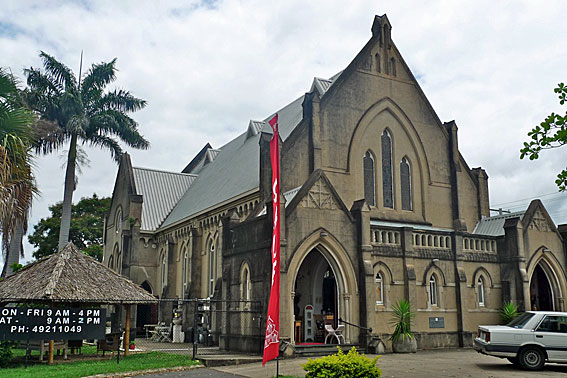
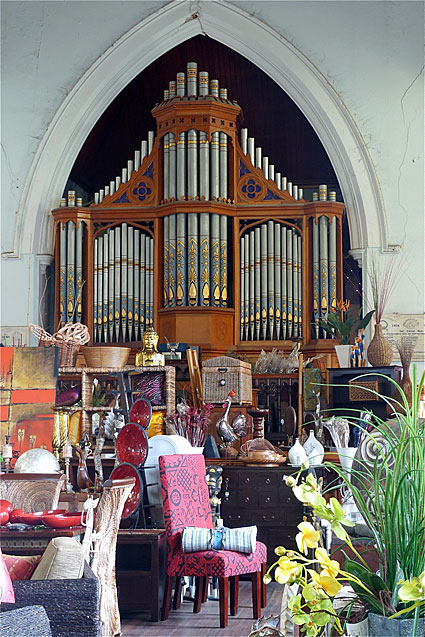
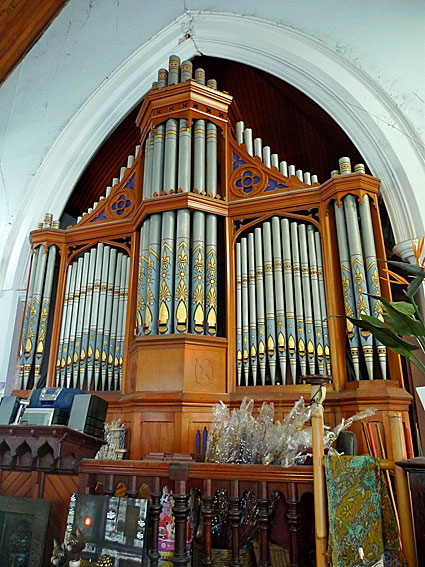
The building used as a secondhand furniture emporium
[Photographs by Trevor Bunning (November 2010)]
In 2018, the building was extensively restored as 'The Church Events Venue', a business specialising in 'weddings from ceremony to reception' as well as corporate events. An external courtyard and octagonal pavillion were added, and the interior was repainted to the original colours.22 The organ remains the visual centrepiece of the interior, and the possibility of hearing it played again has been revived.
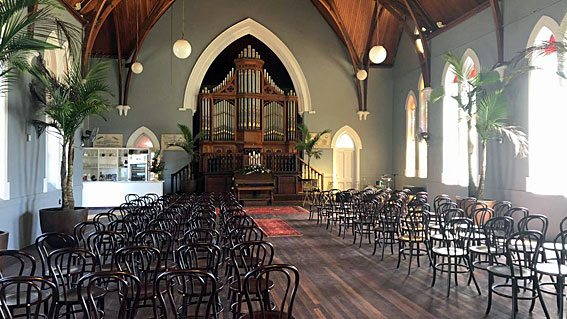
The building used as 'The Church Events Venue'
[Photograph from Facebook page of 'The Church Events Venue' (August 2018)]
Although the instrument's integrity has been compromised, most notably through the introduction of cone-pallet chests in 1933, it retains all of the original pipework in its intended configuration, as well as the attractive original casework.
___________________________________________________________________
1 John Bayton, The Cathedral Church of Saint Paul the Apostle [St Paul's Cathedral Handbook: A History and Guide] (Rockhampton, Record Printing, 1970), p. 5.
2 Richard Bardon, The Centenary History of the Presbyterian Church of Queensland (Brisbane: W.R. Smith & Paterson, 1949), pp. 250-51.
3 Queensland Heritage Council, Queensland Heritage Register, location 600785; Alexander Hay, Jubilee Memorial of the Presbyterian Church of Queensland 1849-99 (Brisbane: Alex Muir, 1900), p. 31. [Alexander Hay was the minister of this church, 1876-1913]
4 Donald Watson & Judith McKay, Queensland Architects of the 19th Century: A Biographical Dictionary (Brisbane: Queensland Museum, 1994), p. 201.
5 The Organist and Choirmaster, vol. 7, no. 79 (15 November 1899), p. 147.
6 The Organist and Choirmaster, vol. 7, no. 79 (15 November 1899), p. 147; details in square brackets noted by G. Cox & John Maidment, July 1974.
7 Hay, op. cit., p. 31; Bardon, op. cit., p. 251.
8 Graeme Rushworth, Historic Organs of New South Wales: The Instruments, Their Makers and Players 1791-1940 (Sydney: Hale & Iremonger, 1988), pp. 326-29.
9 The Morning Bulletin (Rockhampton, Friday 6 April 1900), p. 5.
10 The Morning Bulletin (Rockhampton, Friday 27 June 1900), p. 4.
11 Whitehouse Bros Ledger (1922-1940), p. 91.
12 Whitehouse Bros Ledger (1922-1940), p. 289.
13 The Central Queensland Herald (Rockhampton, 3 August 1933), p. 16.
14 Newspaper clipping from Evening News (Tuesday, 1 August 1933), supplied to G. Cox by Kevin Whitehouse, c.1974.
15 Whitehouse Bros Ledger (1940-1954), p. 267.
16 Personal communication to G. Cox from H.W. Jarrott, c.1987.
17 Personal communication to G. Cox from Roger Marks, 2010. The 1928 City Congregational Church organ was purchased by the Baptist Church, South Brisbane, where it was rebuilt by H.W. Jarrott in 1983-84, without the original console.
18 The Organ Voice, vol. 19, no. 3 (December 1991), p. 55; Personal communication to G. Cox from Ray Smith, August 2017.
19 Specification noted by Trevor Bunning, November 2010.
20 Personal communications to G. Cox from Roger Marks, 2002 and 2016; The Morning Bulletin (Rockhampton, 7 October 2002).
21 Vanessa Jarrett, 'Church Restored to Former Glory,' The Weekend Bulletin (Rockhampton, 8-9 September 2018), pp. 18-19.
22 Jarrett, pp. 18-19; Personal communications to G. Cox from Roger Marks, 2018; Facebook page of 'The Church Events Venue'. https://www.facebook.com/pg/The-Church-Events-Venue-330891974353240/about/?ref=page_internal - accessed August 2018.
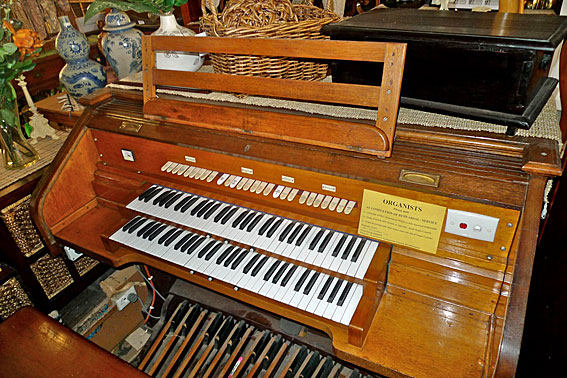
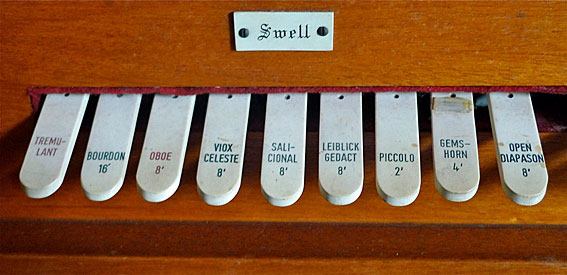
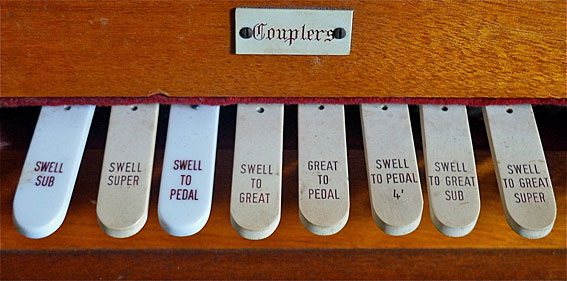
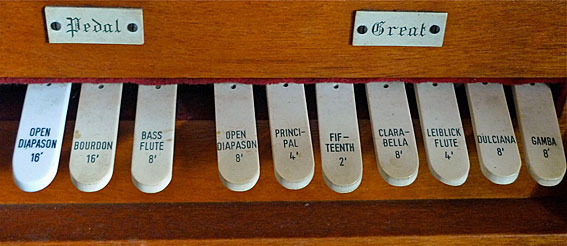
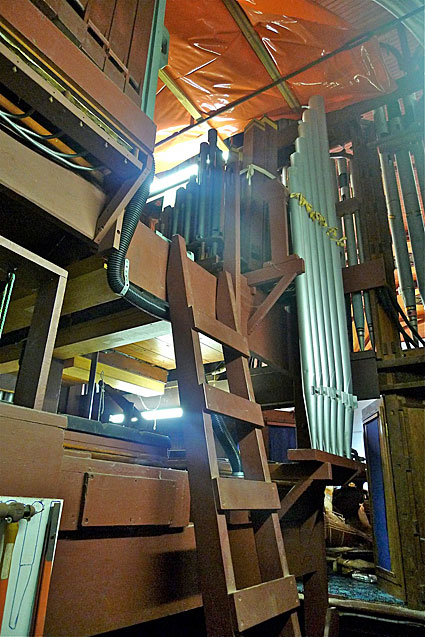
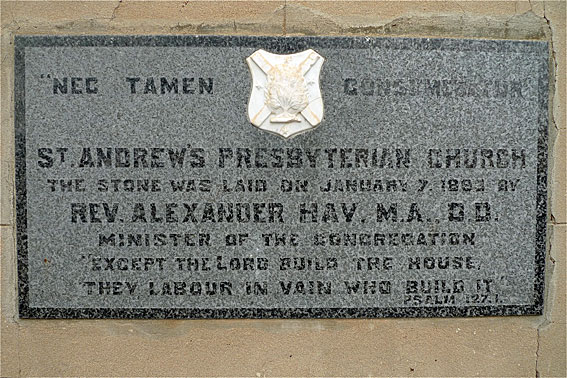
[Photographs by Trevor Bunning (November 2010)]